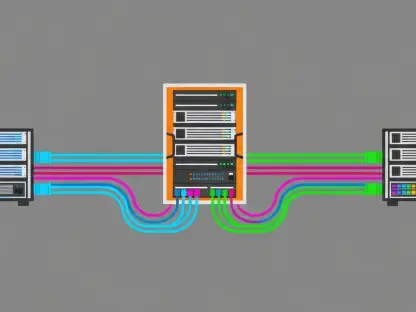Investors confronted a rare one-two catalyst that rewired expectations for a mid-cap infrastructure player almost overnight, as IREN disclosed a $9.7 billion GPU cloud services pact with Microsoft alongside a $5.8 billion equipment purchase agreement with Dell designed to lock down supply during an industry-wide chip crunch. The sequence presented a full-stack strategy in a single stroke: demand certainty from a hyperscaler and procurement muscle to fulfill it. That pairing reframed IREN’s profile from opportunistic participant to committed provider, a shift that helped propel the stock and recast valuation debates. Beyond the headline amounts, the deals suggested execution pathways that reduce ambiguity around timelines, capacity ramps, and return hurdles. Investors reacted to more than scale; they responded to a blueprint that mapped contract obligations to concrete hardware flow, with the potential to convert a hot narrative—AI infrastructure scarcity—into booked revenue and deployed compute.
Stock Rally and Intraday Momentum
A sharp rebound in sentiment translated into heavy trading and steady follow-through, with IREN shares up 11.97% at 12:14:14 EST on Monday, November 24, building on an initial jump of roughly 22% after the Microsoft disclosure. The pattern implied a fast repricing, then a measured consolidation as investors handicapped earnings power tied to contract milestones. In a market attuned to capacity signals, the stock’s resilience hinted that participants viewed the Dell procurement as equally pivotal to the services win. Liquidity on the tape improved as momentum accounts and long-only funds appeared to rotate toward names offering credible exposure to GPU-driven workloads, and intraday dips found buyers. While volatility remained elevated, price action suggested that the headline risk skew had shifted favorably, with downside tempered by contract visibility and upside linked to execution outperformance across deployment phases.
Momentum also reflected a broader reevaluation of comparable plays, where supply bottlenecks and uncertain demand funnels often clouded forecasts. By contrast, IREN surfaced with a clearer match between workload commitments and incoming hardware, a distinction that can compress risk premiums in the near term. Short covering likely amplified the early move, yet the bid persisted even as spreads narrowed, indicating incremental demand beyond fast money. Moreover, volume stayed stout after the open, pointing to renewed conviction among investors who had previously viewed IREN as capacity constrained. Technicals added a tailwind: a decisive break above recent resistance invited trend followers, while the absence of heavy insider selling chatter reduced skepticism. That backdrop set a durable tone for the session as the market worked to price a multi-year contract cycle into nearer-term revenue models.
Microsoft’s $9.7B GPU Cloud Services Anchor
The Microsoft agreement offered a demand anchor that reaches beyond headline magnitude to reshape IREN’s operating cadence and customer mix. Multi-year services tied to GPU-intensive workloads create recurring revenue with higher visibility, and alignment with a hyperscaler can improve utilization planning, uptime targets, and service-level discipline. For Microsoft, tapping a partner focused on GPU cloud capacity diversifies supply, while for IREN, the relationship elevates enterprise credibility and opens cross-sell avenues in adjacent compute and data services. Importantly, a marquee customer tends to set quality and security standards that ripple through an organization, sharpening processes around deployment, monitoring, and cost governance. The contract therefore functions as both revenue engine and operational forcing mechanism, nudging IREN toward enterprise-grade scale and predictability.
Strategically, the deal inserts IREN into the flow of AI training and inference workloads that define the current compute cycle, from large language models to fine-tuning and edge-adjacent services. That positioning helps mitigate cyclicality tied to legacy demand, bringing exposure to faster-growing segments where performance density and latency matter more than raw capacity. It also raises the bar on telemetry, scheduling, and power efficiency, since hyperscalers expect partners to deliver consistent throughput under aggressive SLAs. The associated data gravity—storage, networking, and interconnect—can compound revenue per rack over time as customers co-locate complementary services. While no contract removes execution risk, embedding with Microsoft reduces demand volatility and can improve financing optionality, as capital providers often price risk differently when revenue streams are backed by blue-chip counterparties.
Dell’s $5.8B GPU Procurement and Capacity Build-Out
If the Microsoft agreement set the demand curve, the Dell purchase plan described the supply path, bridging a critical gap in a market defined by GPU scarcity and long lead times. Access to high-end accelerators and the surrounding infrastructure—servers, cooling, power distribution, networking—determines how quickly capacity can be brought online and monetized. By committing $5.8 billion to equipment, IREN moved to de-risk deployment schedules, align deliveries with contract milestones, and secure favorable terms on service, spares, and integration. The agreement also signals that configuration choices were made with workload specificity in mind, aiming for optimal performance per watt and serviceability that shortens maintenance windows. In an environment where months matter, that kind of procurement clarity can be as valuable as the services contract it underwrites.
The procurement also tightens the feedback loop between design, install, and operational tuning, potentially trimming time-to-revenue for each deployment wave. Pairing Dell’s manufacturing scale with IREN’s site readiness plans can streamline staging and validation, reducing surprises that often emerge when heterogeneous components converge under peak load. Moreover, locking in a pipeline of accelerators helps stabilize pricing and hedge against supply shocks, an advantage when rival bidders compete for the same chips. As capacity ramps, lessons from early clusters can be rolled into subsequent builds, improving yield on installed capital. The net effect is a practical hedge on execution risk: secured hardware flows meet obligated services, while process improvements drive incremental efficiency that compounds over successive cohorts of GPU deployments.
Analyst Upgrades and Market Validation
Wall Street’s response mapped closely to the narrative pivot. Cantor Fitzgerald raised its price target on IREN from $100 to $142 and maintained an Overweight rating, citing the transformative scale of the Microsoft contract and the clarity provided by the Dell procurement. Roth Capital lifted its target to $94, underscoring conviction in a longer runway for AI cloud and data center services as IREN’s capacity story gains traction. These revisions suggested that analysts now model higher utilization, improved revenue visibility, and better unit economics as the company scales. They also highlight a shift in perceived competitive positioning: rather than chasing episodic workloads, IREN was seen aligning with durable demand from a hyperscaler, which supports more confident multi-quarter forecasting.
The endorsement did not ignore risk. Coverage notes emphasized execution as the critical swing factor, particularly around installation pacing, power availability, and cluster optimization. Yet the market seemed to accept that securing supply at scale addressed the most daunting bottleneck, allowing attention to pivot toward operational excellence and capital efficiency. Price target dispersion narrowed, reflecting a convergence around scenario ranges anchored by contracted revenue. Importantly, the tone of commentary moved from speculative to pragmatic—less about whether IREN could access chips, more about how quickly it could translate hardware into billable GPU hours. In aggregate, the upgrades helped validate that valuation multiples near growth leaders were not purely hope-driven but tethered to identifiable catalysts and a measurable build plan.
Financial Snapshot and Industry Context
Recent results added ballast to the story. For Q1 FY26, IREN reported revenue of $501.02 million, net income of $384.61 million, and diluted EPS of 1.08, with operating income improving despite impairment charges. A price-to-earnings ratio of 39.13 indicated the market was paying up for growth, while management pointed to solid liquidity that can support near-term deployment commitments. That footing matters as capital intensity rises: site preparation, power provisioning, and thermal solutions require sustained outlays before cohorts of GPUs begin generating cash. Against the broader backdrop of an AI infrastructure race, the combination of contracted demand and secured supply placed IREN within a smaller set of operators positioned to scale without relying on opportunistic chip allocations or uncertain resale channels.
The industry context also offered cues for next steps. Power availability, interconnect choices, and cooling strategies remained pivotal levers for performance per dollar, and operators that fine-tuned these variables tended to compress payback periods. For IREN, the logical path emphasized phased activations tied to acceptance tests, disciplined capex cadence synced to deliveries, and continuous firmware and scheduler optimization to elevate throughput. Partnerships beyond silicon—networking, storage, and orchestration—could unlock incremental yield on deployed racks. In practice, the roadmap favored measurable milestones over splashy promises, and the day’s developments suggested that the company had shifted from promise to plan. On balance, the setup looked actionable, the risk profile had improved, and the investment case had evolved from conjecture to execution.









